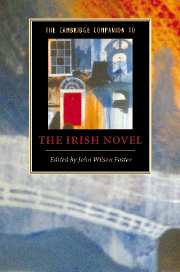Book contents
- Frontmatter
- Introduction
- 1 The novel before 1800
- 2 The national tale and allied genres, 1770s-1840s
- 3 The novel of the big house
- 4 The Gothic novel
- 5 Catholics and fiction during the Union, 1801-1922
- 6 Irish modernisms, 1880-1930
- 7 James Joyce
- 8 Region, realism and reaction, 1922-1972
- 9 The novel in Irish
- 10 Women novelists, 1930s-1960s
- 11 Two post-modern novelists: Samuel Beckett and Flann O’Brien
- 12 Life writing in the twentieth century
- 13 The novel and the Northern Troubles
- 14 Contemporary Irish fiction
- Index
13 - The novel and the Northern Troubles
Published online by Cambridge University Press: 28 January 2007
- Frontmatter
- Introduction
- 1 The novel before 1800
- 2 The national tale and allied genres, 1770s-1840s
- 3 The novel of the big house
- 4 The Gothic novel
- 5 Catholics and fiction during the Union, 1801-1922
- 6 Irish modernisms, 1880-1930
- 7 James Joyce
- 8 Region, realism and reaction, 1922-1972
- 9 The novel in Irish
- 10 Women novelists, 1930s-1960s
- 11 Two post-modern novelists: Samuel Beckett and Flann O’Brien
- 12 Life writing in the twentieth century
- 13 The novel and the Northern Troubles
- 14 Contemporary Irish fiction
- Index
Summary
The political novel before 1969
For the Irish novelist, the usual concerns of the English novel - personal morality and relationships - have tended to be subordinated to the more pressing issues of race, religion and nationality. The early Irish novelists, Maria Edgeworth and Sydney Owenson (Lady Morgan), attempted a reconciliation between Ireland's two nations, Edgeworth through social reform and political unionism, Owenson through Ascendancy commitment to a romantic nationalist movement which, in literature, would culminate in the work of W. B. Yeats. The big house theme inaugurated by Edgeworth and Owenson (see chapter 3 above) has continued to fascinate novelists to the present day, as Jennifer Johnston's The Captains and the Kings (1972), The Gates (1973), How Many Miles to Babylon? (1974) and The Old Jest (1979) would indicate. These novels, written at the height of the Northern Troubles, offer an oblique perspective on the conflict, and the setting of the novels in the past, in the south, suggests flight from the intractable reality of contemporary Northern Protestant unionism/loyalism in 1970s Ulster.
- Type
- Chapter
- Information
- The Cambridge Companion to the Irish Novel , pp. 238 - 258Publisher: Cambridge University PressPrint publication year: 2006

